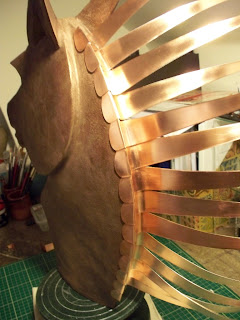

Sculptures with a theme of erosion, and I decided to combine this with an intended post about Reflection, otherwise this blog would end up being overly repetitive.
There two lines of enquiry with regards to my ceramics. On the one hand my work takes on rather solid linear forms, either through throwing or slab building. On the other hand I am deeply fascinated by the processes of erosion and change in nature, for reasons I cannot put into words. Inchoate. If I am fortunate to be at a beach, I would hope to see the drainage patterns made in sand when the tide turns. Large scale river deltas echoed in miniature and, better yet, can be observed forming in real time.
Eroded Vessel
The heavily grogged clay body of crank has a very rough texture when left unglazed. When fired at glazing temperature it has the colour and texture of a coarse grained dark sand. This was perfect for realising this design.
This was built simply through coiling. Then it was just a matter of carving away clay to simulate the patterns resembling the drainage rills on a beach. It would have been fun to try actually dripping water onto the vessel. One day, when (or if) I have a proper studio and time, I will actually try this to see how the clay behaves.
Spiky Form (see Post #2)
The gnarly texture of this sculpture is a study of transition. It is meant to look semi-natural, like tree bark - what was once a clean smooth spike has grown old and fissured, and now giving way to new spikes. The smoother, rippled side is influenced by just that - ripples on a beach.
Menhirs (see Post #5)
Already seen in the last post. The 'acid pitting' texture now has its proper context. Humans, and I mean humans in general, all over the planet are busily reshaping the surface of the planet, albeit on a scale very, very tiny relative to Earth as a whole. Some reshaping is significant enough to be clearly seen from space. So this begged the question: are humans a force of nature, just as much as wind and water? We are instinctively familiar with the differences between natural and man-made. But I think it is true that what man is doing in its activities, has to be considered natural. That isn't to say that all things we do are right (a lot of what mankind is doing is very wrong in my opinion). I digress. The issue, my argument, is that erosion is taking many forms beyond the patterns made by physical forces as a consequence of Humanity having big brains.
I eroded the surface of this menhir to create a surface that looks like it was eroded naturally...

Cracked Vessel (photos at top)
Spiky Form (see Post #2)
The gnarly texture of this sculpture is a study of transition. It is meant to look semi-natural, like tree bark - what was once a clean smooth spike has grown old and fissured, and now giving way to new spikes. The smoother, rippled side is influenced by just that - ripples on a beach.
Menhirs (see Post #5)
Already seen in the last post. The 'acid pitting' texture now has its proper context. Humans, and I mean humans in general, all over the planet are busily reshaping the surface of the planet, albeit on a scale very, very tiny relative to Earth as a whole. Some reshaping is significant enough to be clearly seen from space. So this begged the question: are humans a force of nature, just as much as wind and water? We are instinctively familiar with the differences between natural and man-made. But I think it is true that what man is doing in its activities, has to be considered natural. That isn't to say that all things we do are right (a lot of what mankind is doing is very wrong in my opinion). I digress. The issue, my argument, is that erosion is taking many forms beyond the patterns made by physical forces as a consequence of Humanity having big brains.
I eroded the surface of this menhir to create a surface that looks like it was eroded naturally...

Cracked Vessel (photos at top)
The 'Cracked Vessel' is an extension of the concept above and combines with the theme of the next and final post in this series.
This is an extension of a degree project, 'Object of Desire' (below). We were tasked with creating an object that had properties of things we like. I combined 'naturalistic' clay sculpture with mirror surfaces that represents pure metal.
This is an extension of a degree project, 'Object of Desire' (below). We were tasked with creating an object that had properties of things we like. I combined 'naturalistic' clay sculpture with mirror surfaces that represents pure metal.
~Jay, July 2021
P.S. Yes it took a really long time to get around to finishing off this entry.



















































